Irish Terrier
May 26, 2021 2021-05-26 13:29Table of Contents

Origin and History of the Irish Terrier

The Irish Terrier is an energetic dog that loves people, making it one of the best breeds for families. Unfortunately, the breed’s origin is a little unclear since Terriers have been bred for many centuries.
Apparently, Irish Terriers emerged sometime in the 19th century. In 1885, they received the American Kennel Club’s official recognition. The breed was extremely popular with farmers since these dogs make excellent watchdogs and can hunt down vermin.
The Irish Terrier’s golden moment was during World War I, when the breed was largely used for sending out messages between troops, acting as sentinels, and keeping the camps free of rats and other critters that could have easily spread diseases to the soldiers.
While the dog breed is less common these days, the Irish Terrier does have a loyal following mostly due to its trainability, affection for humans, and overall happy personality.
Appearance of the Irish Terrier
Irish Terriers are light-footed, medium-sized, and elegant. They come in a variety of colors, and they range from red and red wheaten to rust and wheaten red. The dog’s coat should lie close to the body and have a somewhat wiry texture. Only a small amount of white should be present on the chest.
Irish Terriers have a muscular and deep chest, but it shouldn’t be wide. The dog’s front legs are straight and long while the back legs are muscular and strong. The tail should be carried high without it being curled forwards.
When it comes to size, the ideal height of the breed is 18 to 19 inches (46-48 cm). Females are typically smaller than males. Irish Terriers don’t usually get heavier than 30 pounds, with their average weight being between 25 and 27 pounds.

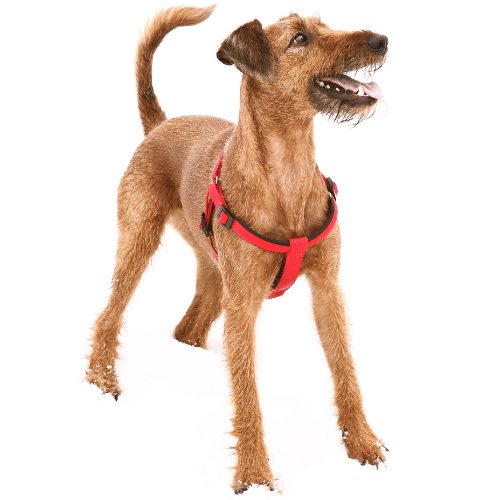
Temperament of the Irish Terrier
The breed was used for home protection and hunting, and that’s because Irish Terriers are full of energy, alert, but they are also adaptable and good-tempered. Their curiosity can sometimes put them in danger, which is why these dogs have to be trained as early as possible.
While they do well with human friends, they might not socialize as easily with other animals and dogs, in particular. For this reason, early socialization is necessary, especially if you know that you will get another dog in the future or if you already are a dog parent.
Irish Terrier puppies are playful and as curious as their adult counterparts. Since they get attached to their owners, they can suffer from separation anxiety.
Irish Terrier Health and Care
All dog breeds have some likelihood of developing genetic conditions, which is why getting your puppy from a reputable breeder can be crucial. Fortunately, this breed is generally healthy, with a lifespan of 13 to 14 years.
One of the rarest diseases that Irish Terriers can suffer from is muscular dystrophy. Here are several other health issues that they can develop. Talk to your vet about how you can prevent them.
- Cataracts
- Progressive retinal atrophy
- Hyperkeratosis (pad thickening)
- Hip and elbow dysplasia
- Urolithiasis
- Cystinuria
Out of all of the complications that Irish Terriers can develop, hyperkeratosis and cystinuria are the two that seem to affect the breed the most. Cystinuria (urinary bladder stones) typically appears in males around the age of 4 and is resolved through neutering.
Hyperkeratosis is caused by a rare gene that’s more prominent in Europe. In North America, responsible breeding has led to it being a minor concern since its occurrence has been significantly reduced.
According to the Irish Terrier Club of America, this breed can also develop hypothyroidism. Keep in touch with your veterinarian and take your puppy to regular check-ups at least twice a year.


Grooming Your Irish Terrier
An Irish Terrier’s coat is different compared to that of other dogs. If you groom it regularly, your Irish Terrier puppy will never have skin and coat issues and shedding is not going to be a problem. Dogs need stripping once or twice a year. Frequent haircuts are not recommended as the coat might lose its weather-resistance and become soft instead.
Regular bathing is also not advised since it can affect the structure of the hairs and remove the oils that the dog’s skin needs in order to remain healthy. Brush your pooch’s coat every week.
Since some Irish Terriers might not enjoy grooming, it’s important for you to get your canine friend accustomed to a routine as early as possible. The rest of the grooming is rather basic, such as trimming the nails every other week and cleaning your dog’s teeth with a vet-approved toothpaste (which can prevent periodontitis).
Training Your Irish Terrier
The Irish Terrier is a very smart dog breed, but it can also be extremely stubborn. If you want to convince your dog to do something against its will, it is quite likely that you will be disappointed. Moreover, this can also affect your bond.
Positive reinforcement is the right way of going about things when training an Irish Terrier puppy. These dogs pick up tricks and commands in a timely fashion since they are extremely clever. However, long training sessions can bore and tire them. That’s why you should train your dog with two to three 10-minute sessions every day.
Obedience training can make your Irish Terrier friend less disobedient and single-minded. Keep in mind that these dogs can be hyperactive, especially if they don’t have any opportunities to consume their energy during the day.
They need about two hours of physical activity per day. If you don’t want any destruction in your home, you should get an Irish Terrier only if you have a house with a yard and you have the availability to regularly get your dog new toys.
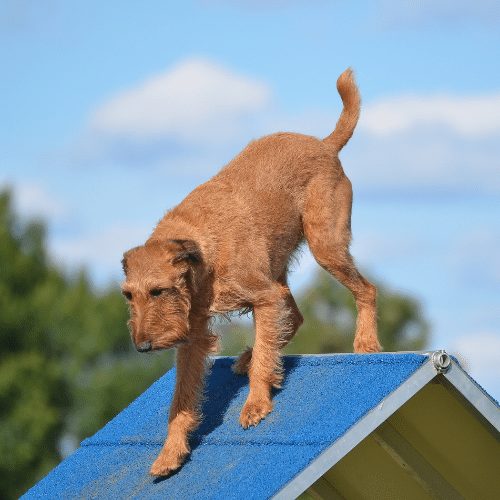
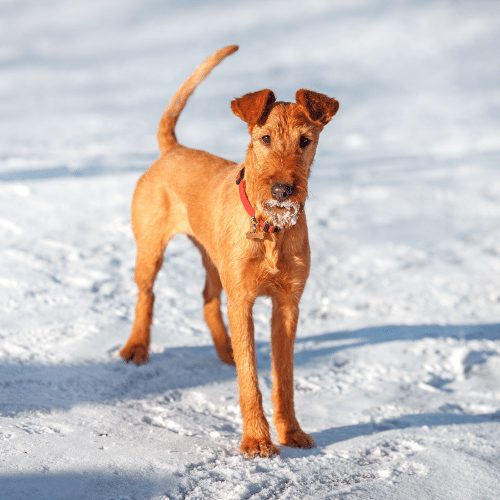
Deciding on a Irish Terrier
Getting an Irish Terrier puppy is a serious and long-term commitment since these dogs live for at least 12-13 years. If you are unsure whether this is the right dog breed for you, you might want to know that compared to many others, the Irish Terrier is less likely to suffer from medical problems, so you will be getting a generally healthy dog.
The most important thing to consider when getting this type of dog is whether you have enough time to devote to your canine friend or not. Caring for a terrier can be very challenging if you are out of the house for ten or more hours per day.
Irish Terriers need to interact with humans to be good-tempered, and they can get severely depressed and anxious when left alone for a long time. If you’re considering getting a puppy, contact a breeder in your area and ask them whether you can go and visit their kennel.
Also, get in touch with other Irish Terrier parents through social media — they can give you some useful advice, and they might even organize meet-ups in your area.
An Irish Terrier is not the right dog for you if:
- You’re not patient enough to wait for a puppy (since they can be pretty rare)
- You can’t handle stubbornness and barking
- You can’t keep your dog busy with outdoor activities on a regular basis
An Irish Terrier is the right dog for you if:
- You want a great watchdog
- You’re looking for a dog that doesn’t shed much
- You have enough time for walks and playtime in the park

Finding An Irish Terrier Puppy Breeder
When it comes to getting an Irish Terrier puppy, you have three options. One of them is getting the puppy from a dog rescue organization, another would be for you to adopt from a public animal shelter, and there’s also the option of you getting the dog from a reputable breeder.
Finding a breeder can be rather challenging, especially since Irish Terriers aren’t as common today as they used to be at the beginning of the 20th century. After you get in touch with the breeder, you should look for several references online to find out if they breed healthy puppies.
Ask your dog breeder whether they can show you a Canine Eye Registry Foundation certificate for the puppy and the parents (dated within the past 12 months). Irish Terriers are prone to developing eye conditions, and treating them can be difficult and expensive.
Questions for your breeder
- How long have you been breeding Irish Terriers for?
- Do you have references?
- Is the puppy vaccinated? Is the puppy socialized?
- Are the parents of the puppy in perfect health? Can I see them?
How much is an Irish Terrier Puppy?
Irish Terrier puppies typically cost anything between $600 and $1,000, but they can be more expensive if the parents have won competitions and are free of diseases, for example.
It is better to spend a little more on your puppy and get it from a breeder you can trust.
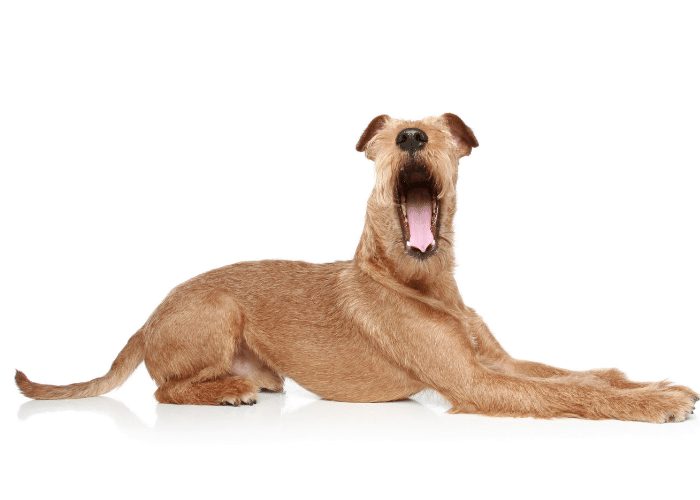
What Irish Terrier Owners Say:
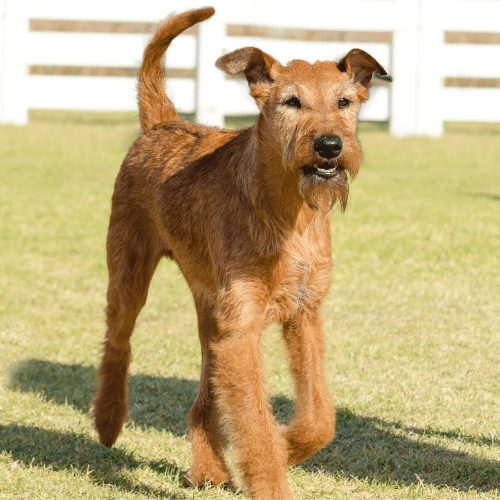
What I found to be interesting about him is that he sometimes needs his time alone, especially after a long playtime session. I didn’t expect that from Rudy since everyone told me that Irish Terriers are always looking for new ways to have fun. He has brought me a lot of joy, and I can’t imagine my life without him now.

We did have a small problem with chewing at first, but since he’s such a quick learner, training him was a breeze. He loves to spend time with our nephews when we go visit them and even gets along with their cat! Fortunately for us, the breeder had already socialized Dexter, so we don’t have to worry about him becoming aggressive towards other dogs.



